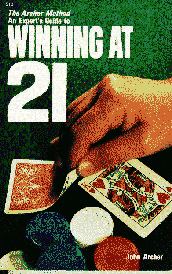

The word "gamble" does not apply to casino games: there is no gamble--- you will lose! Millions of people who visit Las Vegas and Reno will tell you this fact, if they would only wake up and notice how much money they lose. The very existance of casinos confirms that fact. It is a fool's errand to go to a casino, put money on the craps table, or the roulette table, or placed on the Keno bar, or put in the slot machines, and expect to receive more money than one put in. I believe the same is true at the Twenty-One (Blackjack) tables.
Mr John Archer thinks otherwise. In 1973 he wrote a book called The Archer Method. An Expert's Guide to WINNING AT 21. (ISBN 0-87980-328-2) His book explains his method, and gives a brief history of how the method evolved. (Basically he took the existing "basic method" and refined it.) I read the book and remained a skeptic.
Ah, but the challenge of actually winning, consistantly, at Twenty-One! Wouldn't that be a lot of fun? Never mind profitable: it would be FUN! I am not a gambler, nor am I stupid (as a rule): I therefore do not go to casinos and play their games. However, the Archer Method does yield itself to statistical study via simulation. The rules are firm: a computer can follow them, and never make a mistake.
I decided to write a computer simulation that follows the Archer
Method. The simulation has various "switches" one may throw that
changes from the "basic method" Archer eventually improved, to
the actual Archer Method.

When I ran the simulation under the "Basic Method," (the computer plays the dealer and the player), the "Player" consistantly tied the dealer in wins and losses. This is what Archer said I would see, though I didn't believe him. (Hell, I still do not, and I saw it with my own eyes--- I suspect an error in my simulation programming).
When the Archer Method's most basic improvement ("casing" the deck with a very simple counting system) is turned on, the "Player" consistantly wins, albeit slowly. More specifically, the player (with the basic method plus the Archer "casing" method) wins and loses hands on about a 1:1 ratio. However, the casing method yields a profit via the player knowing when to wager the minimum and when to increase the wager. When all of the "bells and whistles" in the Archer Method are turned on, the "Player" consistantly wins faster.
This comes as a vast surprise to me. I still suspect some errors in my simulation, and I'm going through the code (Visual BASIC 3.0) and a complete print-out of hundreds of hands dealt, to see if there is an error.
The book is 204 pages, counting the index. The method is rather easy to learn, though it takes much practice. Simple graphs and one- or two-page summaries of the method are included. If you are interested in the game of Twenty-One, you should go to the library and look up this book. (I got a copy from Amazon Books.)